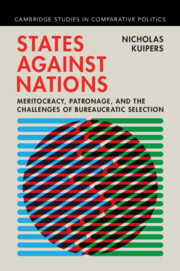Refine search
Actions for selected content:
250 results
2 - Ghost Projects
- from Part I - Ghana–Soviet Entanglements
-
- Book:
- Socialist De-Colony
- Published online:
- 10 November 2025
- Print publication:
- 20 November 2025, pp 80-117
-
- Chapter
-
- You have access
- Open access
- HTML
- Export citation
6 - Utopias, Dystopias, Labor, and Socialist “Contradictions”
- from Part II - Socialist Dreams
-
- Book:
- Socialist De-Colony
- Published online:
- 10 November 2025
- Print publication:
- 20 November 2025, pp 236-265
-
- Chapter
-
- You have access
- Open access
- HTML
- Export citation
3 - Racial Citizenship Moments
- from Part I - Ghana–Soviet Entanglements
-
- Book:
- Socialist De-Colony
- Published online:
- 10 November 2025
- Print publication:
- 20 November 2025, pp 118-162
-
- Chapter
-
- You have access
- Open access
- HTML
- Export citation
What Is Ideological Capture and How Do We Measure It? Using Antitrust Reform to Understand Expert–Public Cleavages
-
- Journal:
- Perspectives on Politics , First View
- Published online by Cambridge University Press:
- 17 November 2025, pp. 1-21
-
- Article
-
- You have access
- Open access
- HTML
- Export citation
2 - Theorising the State and Transitions
-
- Book:
- States of Transition
- Published online:
- 31 October 2025
- Print publication:
- 13 November 2025, pp 25-58
-
- Chapter
- Export citation
The Unitary Executive, the Constitution, and the Trajectory of the Supreme Court’s Approach to the Removal Power
-
- Journal:
- Perspectives on Politics , First View
- Published online by Cambridge University Press:
- 28 October 2025, pp. 1-17
-
- Article
-
- You have access
- Open access
- HTML
- Export citation
Border Bureaucracy and Discourses: Demarcation and Surveillance of the Punjab Border in the Wake of 1947 Partition
-
- Journal:
- Critical Pakistan Studies ,
- Published online by Cambridge University Press:
- 15 October 2025, pp. 1-20
-
- Article
-
- You have access
- Open access
- HTML
- Export citation
4 - The Emerging State and the Constitution
-
- Book:
- Assembling India’s Constitution
- Published online:
- 24 September 2025
- Print publication:
- 09 October 2025, pp 164-200
-
- Chapter
- Export citation
1 - Myths and Mysteries of War in Afghanistan
-
- Book:
- Choosing Defeat
- Published online:
- 07 October 2025
- Print publication:
- 07 October 2025, pp 1-36
-
- Chapter
- Export citation
4 - 2003–2005
-
- Book:
- Choosing Defeat
- Published online:
- 07 October 2025
- Print publication:
- 07 October 2025, pp 106-132
-
- Chapter
- Export citation
16 - Why Did We Lose?
-
- Book:
- Choosing Defeat
- Published online:
- 07 October 2025
- Print publication:
- 07 October 2025, pp 467-495
-
- Chapter
- Export citation
Conclusions
-
- Book:
- Armed Citizens and Citizens in Arms
- Published online:
- 12 September 2025
- Print publication:
- 25 September 2025, pp 208-214
-
- Chapter
- Export citation
2 - Visibility Projects, the First Political Service
-
- Book:
- Politicizing Business
- Published online:
- 29 September 2025
- Print publication:
- 25 September 2025, pp 37-65
-
- Chapter
- Export citation
The southern initiative: How indigenous values inspire social innovation and impact
-
- Journal:
- Journal of Management & Organization , First View
- Published online by Cambridge University Press:
- 08 September 2025, pp. 1-14
-
- Article
-
- You have access
- Open access
- HTML
- Export citation
Chapter 1 - Introduction
-
- Book:
- Performing Justice in the Later Roman Empire
- Published online:
- 07 August 2025
- Print publication:
- 21 August 2025, pp 1-25
-
- Chapter
- Export citation
Chapter 2 - Petitions
-
- Book:
- Performing Justice in the Later Roman Empire
- Published online:
- 07 August 2025
- Print publication:
- 21 August 2025, pp 26-50
-
- Chapter
- Export citation

States against Nations
- Meritocracy, Patronage, and the Challenges of Bureaucratic Selection
-
- Published online:
- 14 August 2025
- Print publication:
- 07 August 2025
6 - Meritocracy and Patronage in Colonial Southeast Asia
-
- Book:
- States against Nations
- Published online:
- 14 August 2025
- Print publication:
- 07 August 2025, pp 155-184
-
- Chapter
- Export citation
4 - Waiting: The Seniority System
- from Text 4 - On Making Appointments Fair
-
-
- Book:
- Chinese Statecraft
- Published online:
- 17 July 2025
- Print publication:
- 31 July 2025, pp 61-74
-
- Chapter
- Export citation
Notes on the Difficulty of Studying State Archives in Egypt
-
- Journal:
- Comparative Studies in Society and History / Volume 67 / Issue 4 / October 2025
- Published online by Cambridge University Press:
- 07 July 2025, pp. 785-810
-
- Article
-
- You have access
- Open access
- HTML
- Export citation
